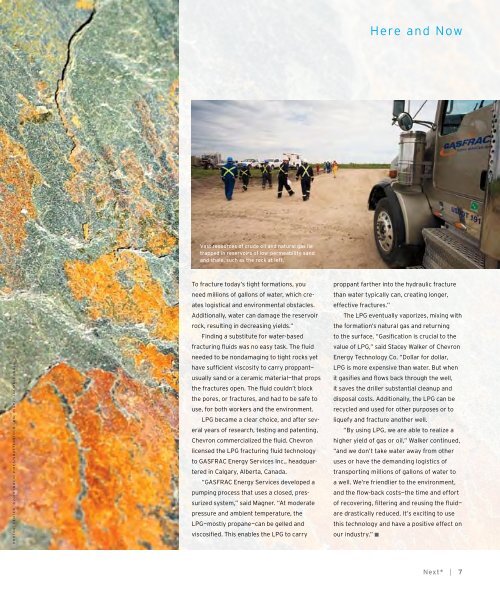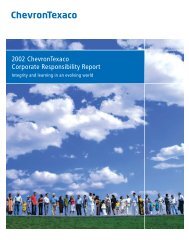Next* Magazine, Issue 4 - Chevron
Next* Magazine, Issue 4 - Chevron
Next* Magazine, Issue 4 - Chevron
- No tags were found...
You also want an ePaper? Increase the reach of your titles
YUMPU automatically turns print PDFs into web optimized ePapers that Google loves.
Here and NowVast resources of crude oil and natural gas lietrapped in reservoirs of low-permeability sandand shale, such as the rock at left.PHOTOS: CENTER, ©2010 INACIO PIRES/SHUTTERSTOCK.COM; RIGHT, JIM MACDONALDTo fracture today’s tight formations, youneed millions of gallons of water, which createslogistical and environmental obstacles.Additionally, water can damage the reservoirrock, resulting in decreasing yields.”Finding a substitute for water-basedfracturing fluids was no easy task. The fluidneeded to be nondamaging to tight rocks yethave sufficient viscosity to carry proppant—usually sand or a ceramic material—that propsthe fractures open. The fluid couldn’t blockthe pores, or fractures, and had to be safe touse, for both workers and the environment.LPG became a clear choice, and after severalyears of research, testing and patenting,<strong>Chevron</strong> commercialized the fluid. <strong>Chevron</strong>licensed the LPG fracturing fluid technologyto GASFRAC Energy Services Inc., headquarteredin Calgary, Alberta, Canada.“GASFRAC Energy Services developed apumping process that uses a closed, pressurizedsystem,” said Magner. “At moderatepressure and ambient temperature, theLPG—mostly propane—can be gelled andviscosified. This enables the LPG to carryproppant farther into the hydraulic fracturethan water typically can, creating longer,effective fractures.”The LPG eventually vaporizes, mixing withthe formation’s natural gas and returningto the surface. “Gasification is crucial to thevalue of LPG,” said Stacey Walker of <strong>Chevron</strong>Energy Technology Co. “Dollar for dollar,LPG is more expensive than water. But whenit gasifies and flows back through the well,it saves the driller substantial cleanup anddisposal costs. Additionally, the LPG can berecycled and used for other purposes or toliquefy and fracture another well.“By using LPG, we are able to realize ahigher yield of gas or oil,” Walker continued,“and we don’t take water away from otheruses or have the demanding logistics oftransporting millions of gallons of water toa well. We’re friendlier to the environment,and the flow-back costs—the time and effortof recovering, filtering and reusing the fluid—are drastically reduced. It’s exciting to usethis technology and have a positive effect onour industry.” ■<strong>Next*</strong> | 7
















